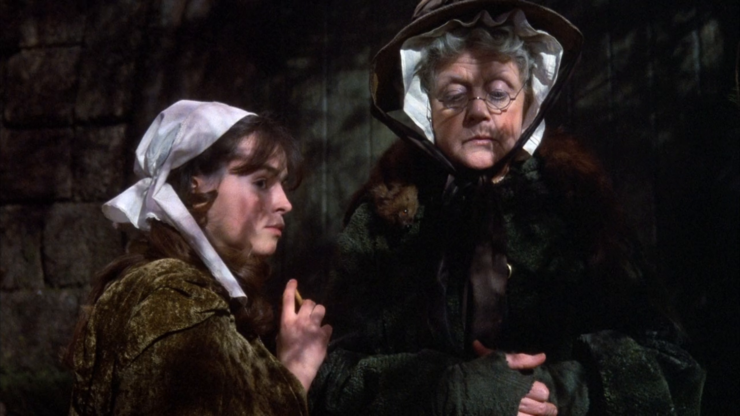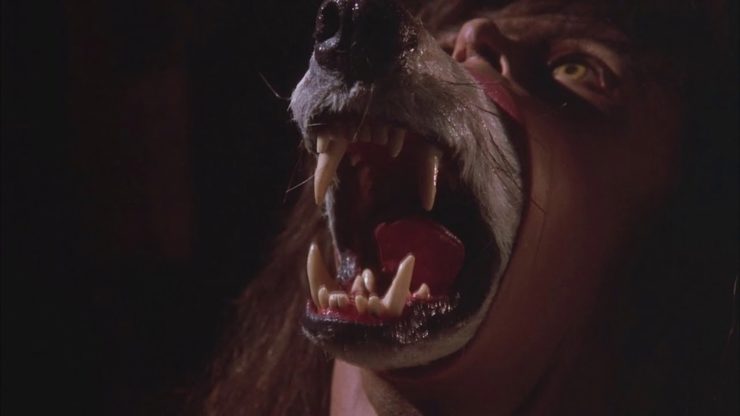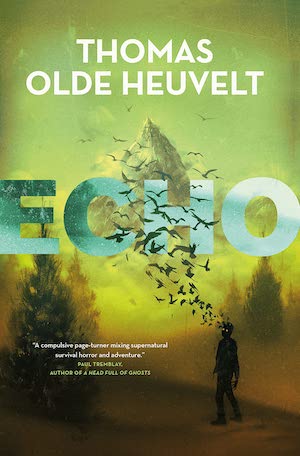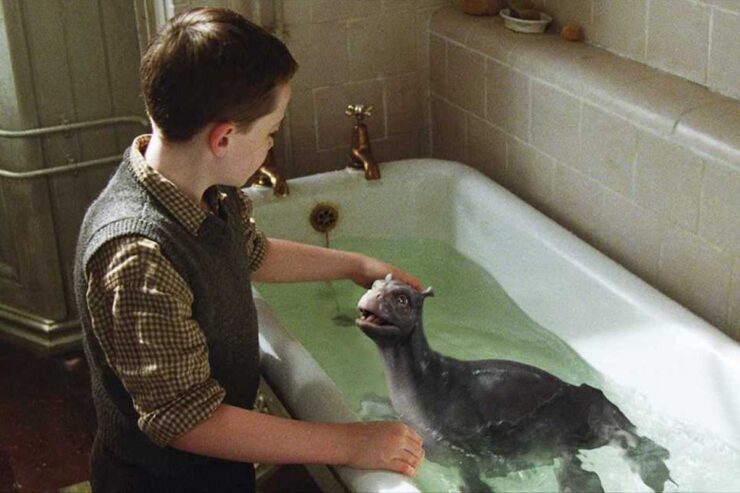I came to this film because of the late, much lamented Angela Lansbury. A film with her in it is always worth watching, and this one fits right into the current chapter of the SFF Bestiary. The Company of Wolves is quite, quite weird. Its auteur, Neil Jordan, is a master of the strange, niche, culty film: The Crying Game, Interview with the Vampire, Byzantium. Jordan cowrote the screenplay with Angela Carter, based on her short story of the same name, a twist on the tale of Little Red Riding Hood published in the 1979 collection The Bloody Chamber. Its star was fresh off one of her most famous roles, as Mrs. Lovett in Sweeney Todd.
Lansbury brings some of that energy to the role of the Granny in the story-within-a-story. The film is a set of nesting boxes: Gothic adventure in remote and crumbling country manor, dream narrative, horror story, fairy tale, Freudian psychodrama. And of course, it’s a werewolf story.
The frame of the narrative is the country house inhabited by a somewhat skewed version of a nuclear family: mummy, daddy, snotty older sister (dressed in filmy white in the best Gothic-heroine style), bratty younger sister. The younger sister, Rosaleen, or “pest” as the elder calls her, is locked in her cluttered, messy room, deep asleep. She’s obviously been into the elder’s makeup, to garish effect.
We enter her dream, which is a strange and eerie place, full of creepy dolls and monstrous toys and dark, ominous landscapes, with flickers of Freud, or is it Jung, in the glistening bodies of frogs and the wings of ravens and the occasional softly glowing white bunny. The heart of it is a dim, shadowy village full of people in fairytale-era costumes, halfway between Colonial Williamsburg and Sixties hippie chic. A family lives here, mother and father and Rosaleen; as we meet them, they’re burying the older daughter, who wandered in the woods and was supposedly eaten by wolves, though there’s no sign of mauling on her pale and perfect body.
Rosaleen is not exactly grieving for her sister. She makes faces at a village boy who has the hots for her, and chews on a gingerbread man her Granny gives her, “to take your mind off things.” Soon enough, the body is buried (with bonus frog hopping away from the dirt falling onto the coffin) and Rosaleen trips lightly off to Granny’s cottage in the woods.
Granny is a repository of literal old wives’ tales and traditional wisdom. She’s knitting a shawl for Rosaleen out of blood-red wool, as soft as kittens, as soft as snow. Granny’s advice consists of three maxims: Never stray from the path, never eat a windfall apple, and never trust a man whose brows meet.

That’s just the first and the frame of a series of tales within tales. There’s a tale of a young woman who married a traveling man with brows that met, who went out on her wedding night and never returned, until years later when she had married again and had children, when he came back and transformed (with truly gruesome effects) into a wolf, only to be beheaded by the new husband; of a young man who received a potion from an older one and transformed into a wolf, but was bound by sentient vines before he could move; of a woman “wronged” by a young nobleman, who crashed his wedding, flaunting her pregnancy, and transformed all the guests into wolves, whom she kept with her to sing to her baby at night; of a she-wolf who came out of the well in the village, who was shot and sought refuge in the churchyard, where she transformed into a human girl, on whom the priest took pity (and evidently somewhat more than that, in light of the ongoing thread about priests siring bastards).
Rosaleen’s own story begins rather innocently, at her sister’s funeral. The village boy courts her with teasing and flowers, until she agrees to go walking with him in the woods after church on Sunday. He does what boys always try to do, until she runs away, vanishing into the wood. He blames wolves rather than himself, and calls out the hunt; the whole village sets off in search of the illusory wolf.
She meanwhile meets a beautiful sparkly gentleman on the path to Granny’s cottage. He makes a bet with her, that he can reach Granny’s house before she can, traveling overland while she stays on the path. He reaches Granny first, of course, which does not turn out at all well for her.
But when Rosaleen finally arrives, she’s literally a match for him. As the villagers come storming in with her mother in the lead, they find a pretty she-wolf sitting by the fire, wearing the necklace that belonged to the dead elder sister, which the mother had given to Rosaleen. The she-wolf escapes through the window, with a beautiful big male wolf running ahead of her. And so we come back through the dream landscape and the creepy, creepy dolls (the one that ticks, ticks, ticks like a metronome–shudder) to real-world (or is she?) Rosaleen in her cluttered room, waking from her dream just as the wolves burst in.
It’s all terribly fraught and symbolic and Freudian. The young girl is discovering herself as a sexual being. She receives traditional wisdom from her granny, which leans heavily on the idea that all men are beasts and women have to do the best they can to tame them. Her mother has a somewhat different view, a little more sex-positive—no, it doesn’t hurt, she assures her daughter—but she’s possibly a beast herself, a she-wolf who came out “from below” and became a human woman. She suppressed the beast; she married a man who doesn’t hurt her, and had daughters, one of whom didn’t survive the wolf.
Rosaleen is the modern feminist in the family. When her sister is killed, she wants to know why everyone is lamenting that no one came to rescue her. “Couldn’t she rescue herself?” She’s curious about sex, interested in learning how courtship works, and not at all afraid of the sparkly stranger whose identity and supernatural species she recognizes well before we see him bursting out of his human skin in wolf form. She accepts him and welcomes him, and ultimately becomes one of his kind.

When the dreamer wakes, she’s terrified. In dreams she may have accepted the nature and force of her dawning sexuality, but in the waking world she’s not ready. It doesn’t matter, in the end. It comes to her regardless.
Growing up as a girl in the Eighties was not too terribly far off this pattern. Trying to balance older values and mores with more modern ones is never easy. It would take another few decades for Rosaleen’s questioning to become the standard rather than an aberration.
Rosaleen doesn’t see the werewolf as a monster. He’s a sexual being, dangerous in his way, but the Granny he kills is not an actual living being; she’s a plaster statue, an image of an older way of seeing the world. It’s her choice to reject the local boy and run off with him.
Unlike the nearly contemporaneous An American Werewolf in London with its passing reference to “the one with Oliver Reed,” The Company of Wolves is an explicit response to The Curse of the Werewolf. There’s an ongoing thread about “priests who make babies,” as an appalled Rosaleen puts it, which includes a sequence about how the darker kind of werewolves are priests’ bastards born on Christmas. The tale of the wronged peasant girl echoes the origin story of Oliver Reed’s character, complete with nasty greedy aristocrats in eighteenth-century costume, the wedding, and the arrival of the pregnant woman.
Buy the Book


Echo
In The Company of Wolves, the woman triumphs over her rapist and his enablers. They become her child’s servants. We don’t exactly know what happens to the child, but it’s possible he’s the sparkly gentleman, who doesn’t die in the end. Instead, he gets the girl—or more accurately, the girl gets him.
It’s all about female agency. Rosaleen won’t let the village boy kiss her, but she kisses him. When she meets the sparkly gentleman (I wonder if Stephenie Meyer knew this film and had it in mind when she wrote her Twilight novels), she easily holds her own. It’s her choice to go with him, and her choice as to which form she takes when she does it.
It’s a very interesting film. Angela Lansbury is wonderful as the Granny who is clearly a witch, what with the cottage in the woods, the crystal ball by the window, and the weird hissy ferrety thing in the shadows that must be her familiar. She’s not quite as out there as Mrs. Lovett, but she has a subtly sinister air about her.
While it’s not explicit, I think she was the woman who married the werewolf—the actress who plays her has the same prominent eyes. If that’s the case, and considering that Rosaleen’s mother may well be the she-wolf who came out of the well, I’m pretty sure Rosaleen comes by her wolfiness honestly. Sex-positive women have existed forever, but how they’ve had to live and what they’ve had to do in order to survive has changed from generation to generation. One hopes for the better.
Judith Tarr is a lifelong horse person. She supports her habit by writing works of fantasy and science fiction as well as historical novels, many of which have been published as ebooks. She’s written a primer for writers who want to write about horses: Writing Horses: The Fine Art of Getting It Right. She lives near Tucson, Arizona with a herd of Lipizzans, a clowder of cats, and a blue-eyed dog.














